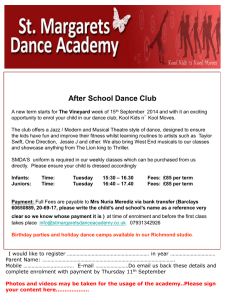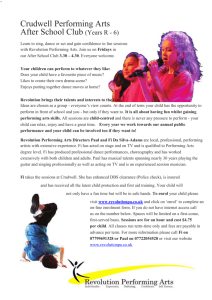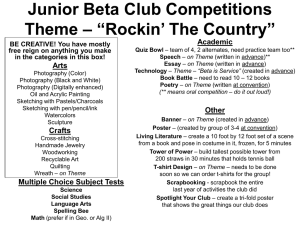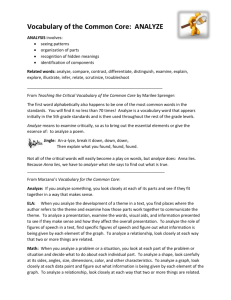Hiding-in-Every-Activity-no-homework-activities-non
advertisement
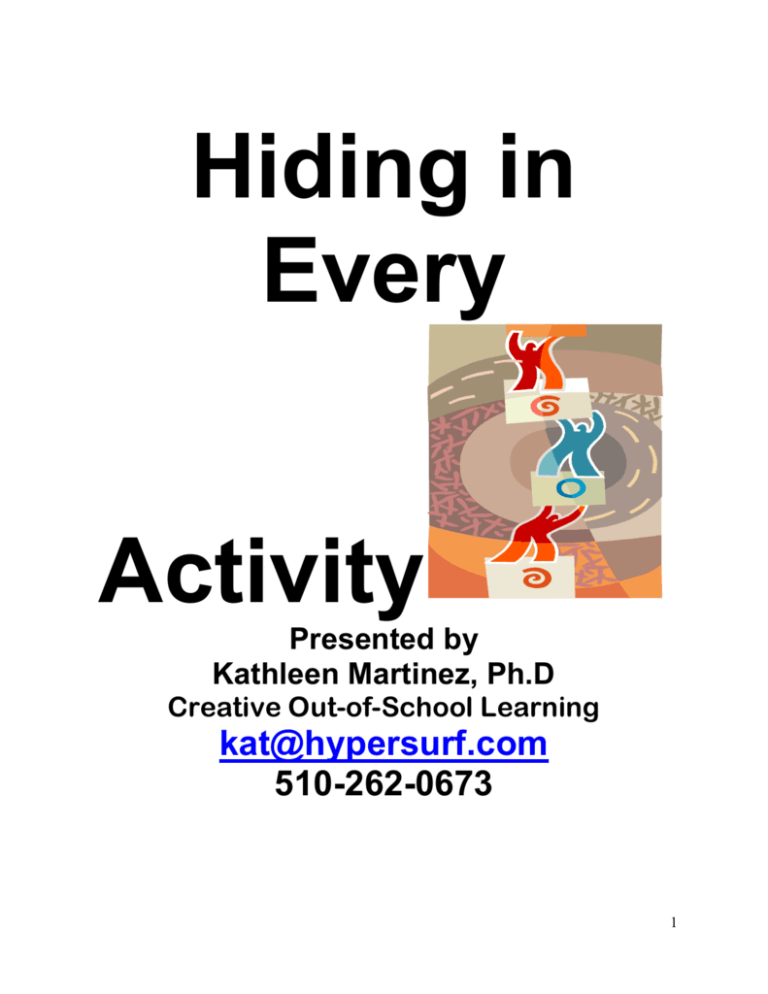
Hiding in Every Activity Presented by Kathleen Martinez, Ph.D Creative Out-of-School Learning kat@hypersurf.com 510-262-0673 1 Workshop Agenda Workshop Overview: This workshop will help participants build an effective learning environment; including integrating project-based activities, sequenced lesson planning, and teaching strategies that engage and motivate. The workshop will also provide feedback and advice about various curricula and how to adapt them to a program’s specific circumstances. Participant Objectives: By the end of this workshop, you will: be able to select age appropriate cognitive/academic, emotional/social, physical and creative skills to develop in program activities be able to design and deliver activity-based and sequential learning opportunities have knowledge of various resources available for activity-based learning Activities: Icebreaker/Group Warm-up activity: Mars Rover Overview of the Workshop and Participant Objectives Identifying age appropriate skills - What are your priorities? Integrating skills into an activities What’s that mean? Clarifying the language around skill building strategies Break Structuring your program for Skill Development - Themes, Projects, Clubs Tools for Planning Activity- Based programs Resources - You don’t need to reinvent the wheel Creating your Action Plan! Reflection/Closing activity: What are you going to do next program day? Workshop Evaluation Action Plan What I Need to Do: With Who? By When? In Conclusion Take a minute to reflect: What important things were covered in this workshop? What did you learn or what was reinforced for you today? Share out. 2 Developmental Considerations for Skill Development FIVE TO SEVEN YEAR OLDS COGNITIVE Very literal and concrete in their thinking Learning how to read and write, but not very good at it yet. May have difficulty understanding written and spoken directions Starts thinking things out, but are not very organized in their thinking SOCIAL-EMOTIONAL PHYSICAL Looks to adults for guidance, encouragement and direction. Have energy highs and lows Full of energy; find it difficult to sit still Tires easily Aware of individual difference in physical appearances Friendships tend to be based on common interests and often shortlived. Learning how to cooperate, but still put themselves first. Can do large motor skill activities Eager to learn, but get frustrated by attempting things beyond their capabilities Investigate, experiment, explore, and Wants to be part of older children’s collect anything and everything. activities Love to do creative activities like Wants a sense of stability and routine. dance, art, theater, music but are not worried about the end product. IMPLICATIONS FOR PRACTICE: Need verbal and hands-on activities and directions. Do not expect them to handle a great deal of reading and writing activities. Work better with adult interaction rather than just other children. Need adults for supervision and support and time to show off want they are doing for adult approval. Get tired of the same activity very quickly. Keep changing the pace and type of activity often. Do not expect them to work on something more than 10 to 15 minutes. May like to do the same thing over and over in exactly the same way. Still are developing their small motor skill Like to test muscle strength and skills They can copy designs and shapes CREATIVE Dance: Aware of their bodies as having a part in the process and like to experiment. Can do a simple dance with a beginning and ending. Music: Sing simple songs and can improvise simple tunes and melodies; not concerned with final product. Theater: “Let’s pretend.” Like to use props. Constantly talking as part of their roles Art: Like to experiment with a variety of art media and craft projects, but are less concerned with the final product than with the process itself. Much more interested in doing than creating a finished product. Like exploring things like nature, numbers and reading, but in a hands-on manner. They like to be active. Running, jumping and climbing is much more appealing than seating and listening. Like to show off what they do physically. Not very coordinated. Do not require activities that require very fine motor skills like complex puzzles, cutting on little things. Children often tell on each, both to get an adult’s attention and help them understand the rules. 3 EIGHT TO TEN YEAR OLDS COGNITIVE SOCIAL-EMOTIONAL PHYSICAL Increasing ability in reading and writing skills Want to discover things for themselves Begin to see adults as fallible human beings Values of peer group generally accepted over those of adults Growing physically at a smooth and uneventful rate Have high energy and can be reckless Beginning to use logic but best if they can see or manipulate objects in order to understand Like increasingly complex task, but need time to practice them Are curious about everything Forming close relationships, mostly with same-sex peers Compare their physical skills with those of their peers Want task to perform, want to feel useful Can make social problems out of physical difficulties- teasing and bullying Begin exhibiting physical differences – girls likely to mature faster Increasing attention span Rituals, rules, secret codes, and made-up language are common Have extreme reactions to many things Are able to work in groups Often try to be perfectionists that can result in frustration May develop special interest in collection or hobbies IMPLICATIONS FOR PRACTICE: Form clubs so that children can feel they are a part of a stable group. Play structured games that have rules, but they may need help in learning and interpreting the rules. Provide opportunities for children to try out real skills, like cooking, sewing, building, gardening and designing. Have them involved in community service efforts. Children learn best by doing. Try to demonstrate instruction for activities or projects. Have them collect things and play problem-solving games like treasure hunts. Have them start thinking about social problems and concerns Fine motor skills have increased Becoming increasing interested in improving personal appearance Increased interest in competitive sports CREATIVE Dance: continue to enjoy experimenting with their bodies, and are interested in variety of dances. They are becoming increasingly skilled. Might be self conscious about pairing up with the opposite sex Music: Willing to try more complex and “performance style” music including more systematic instruction in musical instruments Theater: Can develop story dramatizations. They can write plays based on their imagination. and can put on plays and develop their own props and costumes Art: Willing to experiment; more interested in product and development of specific skills, and are willing to have their products critiqued. Provide opportunities for choice, but do not expect them to come up with their own list of activities. Let them choose from a list of options. Provide time and space for the children that need it to be alone or involved in selfdirected activities. Balance competitive and cooperative games. Take advantage of their ability to read and write. Provide written information, directions and allow them to write about their experiences. Encourage children to talk about their feelings while working or playing together. 4 COGNITIVE Increasingly skilled in using reading and writing to learn rather than learning how to read/write Improved ability to use speech to express themselves Are interested in the adult world Lack long-range planning Think more like adults ELEVEN TO THIRTEEN YEARS OLDS SOCIAL-EMOTIONAL PHYSICAL Tendency to return to childish behavior, fought off by excessive activity Show great hormonal changes and physical growth Require limits Often experience a period of great adjustment Experience mood and energy swings Diet and sleeping habits can be poor Fine motor ability is improving but not totally refined Have a need for privacy Engage in power struggles Close friendships gain importance Experience relationship traumas-get very hurt when rejected by peers More likely to express feelings by action than by words. Dramatic fluctuations of emotions. Moodiness Really interested in exploring their identity. IMPLICATIONS FOR PRACTICE: Give them opportunities to become involved in community service projects. They want to feel like they are contributing. Although they can learn new things through reading, they learn best through projects and hands-on activities in which they apply what they learn. Have them work individually or in small groups on projects that have a product that they can exhibit, such as a performance, art show, and science fair, sports meet. Help them break down project tasks and develop time lines to complete the activities. Encourage them to find things they excel in such as sports, drama, writing, and dance. CREATIVE Dance: Increased level of skill with some participants becoming highly skilled. They can improvise and critique. Interested in the latest dance style. Music: Big part of their life and have acquired their own taste, often based on experience and culture. Some are willing to perform alone or in group, and can write their own compositions Theater – Willing to work in a structure. If interested can be sophisticated performers. Can write, produce and direct plays. Art – Increasingly skilled, and if interested can show high level of skill. Take pride in finished work and can critique and analyze their finished projects. Give them time to hang out their friends without a great deal of structure, but with adequate supervision. Encourage them to explore feelings in safe and structured ways. Be ready for intense mood and energy swings. Sometimes they will act like young adults and in just a few seconds they will have moved into immature behavior. Some children will be more concerned about their looks and prefer not to engage in activities in which they will get dirty. Provide opportunities where they can investigate ideas. They want to solve the world’s problems and have very strong ideas on how it should be done. 5 Social Skills List Adapted from Goldstein’s “The Prepare Curriculum” Beginning Social Skills 1. Listening to adult 2. Listening to a peer 3. Starting and holding a conversation 4. Asking a question 5. Saying thank you 6. Introducing yourself and other people 7. Giving a compliment Advanced Social Skills 1. Asking for help 2. Joining in to an existing group 3. Giving instructions 4. Following instructions 5. Apologizing Skills for dealing with feelings 1. Knowing your feelings 2. Expressing your feelings 3. Understanding the feelings of others 4. Dealing with someone’s else anger 5. Expressing affection 6. Dealing with fear Skill alternatives to aggression 1. Asking permission 2. Sharing something 3. Helping others 4. Negotiating 5. Standing up for your rights 6. Responding to teasing 7. Keeping out of fights Skills for dealing with stress 1. Making a complaint 2. Answering a complaint 3. Sportsmanship after the game 4. Dealing with embarrassment 5. Dealing with being left out 6. Standing up for a friend 7. Knowing how to say “no” appropriately 8. Responding to failure 9. Dealing with an accusation 10. Getting ready for a difficult conversation Planning skills 1. Deciding on something to do 2. Deciding what caused a problem 3. Setting a goal 4. Arranging Problems by importance 5. Making a decision 6. Concentrating on a task Others 1. 2. 3. 6 PHYSICAL EDUCATION SKILLS MOTOR CHECKLIST SKILL BODY MANAGEMENT SUCCESSFUL UNSUCCESSFUL Spatial Awareness Moving Balance Stationary balance Left Right LOCOMOTOR Walk Run Horizontal Jump Vertical Jump Hop Gallop Skip BODY FITNESS Flexibility Aerobic Development Arm-Shoulder Strength Abdominal Strength OBJECT MOVEMENT Self toss Underhand Throw Overhand Throw Catch Bounce Kick Strike Adapted from: http://www.nhcs.net/sped/MANUAL/APE%20-%20PE%20Skills%20Motor%20Checklist.pdf 7 What Do We Want Our Students to Know? Overview of Academic Standards in Selected Subjects English-Language Arts Domains and Strands All Grades have the same Domains. The complexity and expectation of the standards increase through the grades Reading 1.0 Word Analysis, Fluency, and Systematic Vocabulary Development 2.0 Reading Comprehension 3.0 Literary Response and Analysis Writing 1.0 Writing Strategies (Organization, Penmanship, Research and Technology, Evaluation and Revision) 2.0 Writing Applications (e.g. Narratives, Reports, Letters, Technical Writing, Job Applications and Resumes) Written and Oral English Language Conventions (Grammar, Usage, etc.) Listening and Speaking 1.0 Listening and Speaking Strategies ( Comprehension, Organization and Delivery of Oral Communication, Analysis and Evaluation of Oral and Media Communications 2.0 Speaking Applications (Persuasive speeches, multimedia presentations0 Math Standard Domains From K-7, each of these different math domains are covered with increasing depth and complexity 1. Number Sense (Estimation, addition, subtraction, fractions etc.) 2. Algebra and Functions (Number sentences, equations etc.,) 3. Measurement and Geometry 4. Statistics, Data Analysis and Probability (Graphing, Patterns, etc.) 5. Mathematical Reasoning 8th Grade - 12th grade offerings Algebra 1, Geometry, Algebra II, Trigonometry, Mathematical Analysis, Linear Algebra, Probability and Statistics, Calculus 8 Science From K-5, each of these different science areas are covered with increasing depth and complexity 1. Physical Science (i.e light, sound, temperature, chemistry) 2. Life Science (i.e. plants, animal, humans) 3. Earth Science ( i.e. geology, weather, oceans, astronomy) 4. Investigation and Experimentation Middle School Focus 6th grade – Earth Science 7th grade – Life Science 8th grade - Physical Science High School Offerings Physics, Chemistry, Biology/Life Sciences, Earth Science History-Social Studies All grade levels have standards dealing with Historical and Social Science Analysis Skills increasing in depth and complexity Kindergarten: Learning and Working Now and Long Ago Grade One: A Child’s Place in Time and Space Grade Two: People Who Make a Difference Grade Three: Continuity and Change Grade Four: California: A Changing State Grade Five: United States History and Geography: Making a New Nation Grade Six: World History and Geography: Ancient Civilizations Grade Seven: World History and Geography: Medieval and Early Modern Times Grade Eight: United States History and Geography: Growth and Conflict Grade Ten: World History, Culture and Geography: The Modern World Grade Eleven: United States History and Geography: Continuity and Change in the 20th Century Principals of American Democracy and Economics Health Education All grade levels with increasing levels of complexity and depth. Some grades skip certain domains. 1. Nutrition and Physical Activity 2. Growth, Development and Sexual Health (Sexual Health begins in grade 5) 3. Injury Prevention and Safety 4. Alcohol, Tobacco and other Drugs 5. Mental, Emotional and Social Health 6. Personal and Community Health Each Domain has standards that cover the following areas Standard 1 - Essential Health Concepts Standard 2 - Analyzing Health Influences 9 Standard 3: Accessing Valid Health Information Standard 4: Interpersonal Communication Standard 5: Decision making Standard 6: Goal Setting Standard 7: Practicing Health-Enhancing Behaviors Standard 8: Health Promotion Visual and Performing Arts Areas: Dance Music Theater Visual Arts The following standards are found at all grades levels and every performing arts area with increasing levels of complexity and expectation of mastery of the skills involved leading to advanced performance level. 1.0: Artistic Perception: Processing, analyzing, and responding to sensory information through the language and skills unique to the different performing art areas 2.0: Creative Expression: Creating, performing and participating in the performing art area 3.0: Historical and cultural context: Understanding the historical Contributions and Cultural dimension of the performing art area 4.0: Responding to, analyzing and making judgments about works of the performing art area 5.0: Connecting and applying what is learned in the performing art area to learning in other art forms and subject areas and to careers. 10 What’s in a Name? Vocabulary Related to Skill Development Strategies Direct Instruction (after school way): Strategy in which specific skill(s) are taught or reinforced directly. The skills are usually practiced out of context from real life experiences/activities. Examples: o teaching basketball dribbling by doing court dribbling drills o teaching math facts by playing Addition Bingo or using flash cards o vocabulary development using crossword puzzles o staff lectures on a topic Intentional Integrated Skills Development: Strategy in which staff determines skills they want to reinforce, and develop ways to integrate those skills into enrichment activities that are hands-on and active. Can be project based or be integrated into a shorter activity. Examples: o Determining the cost of supplies for a cooking activity (reinforcing money concepts, addition, subtraction etc.) o Making and modifying paper airplanes and holding a paper plane flying contest (Practicing scientific questioning process and collecting data) o Researching facts about animals and making a poster ( research skills, science skills) o Making a friendship bracelet and giving it away with a letter describing why the specific colors were selected ( letter writing and following directions) Project Based Activities: Strategy in which youth are engaged, usually in groups, in learning essential knowledge and life-enhancing skills through an extended, student-influenced inquiry process structured around complex, authentic questions and carefully designed products and tasks. Check out the following website for more information- http://www.sunassociates.com/lynn/pbl/pbl.html Examples: o Painting a Wall mural o Development of a tourist guide for area o Putting on a Kids’ News Show o Producing a Program Year book o Developing an awareness campaign for a social issue Program Structures Tutoring: Individualized or small group systematic support to overcome specific identified deficiencies of youth usually based on diagnostic information Enrichment Classes: Usually enrichment classes are focused on one type of activity with the purpose of increasing the skill in that specific area. Often, direct instruction is a major part of enrichment classes as well as many opportunities to practice the specific sub skills of the activity. (Many times these types of classes are provided by outside providers.) Examples: o Dance class o Welding class o Basketball class o Chess class o Drama class o Guitar class 11 Enrichment Clubs: Can be the same as enrichment classes, but can also integrate different types of activities related to a topic or theme. For example, an Automobile Club might involve reading stories about cars, drawing a futuristic car, and taking apart a motor. The primary purpose of clubs is to expose youth to new ideas and activities, rather than increasing the skills of a particular task. Examples: o o o o Dinosaur club Gardening Club Rocks and Minerals Club Japan club Themes: A topic or subject that is explored using various resources and activities. In afterschool programs, a theme can be explored in a club or can be the organizing principle for much of the program’s activities over a period of time. The Automobile Club described above is an example of a thematic driven club. An example of a theme that provides the organizing structure for much of the program’s activities is the following: o An Ocean Theme Arts and crafts: Tissue Paper Ocean Collage, Shell Boxes, Yarn Octopuses, Jelly fish mobile, Ocean Mural Science: How big is a Baleen Whale? Cleaning Up the Ocean, Power of waves Literacy/Language Arts: Ocean animal Acrostic Poem, Reading When Woman Became the Sea: A Costa Rican Creation Myth, Researching and making a poster on a sea animal Games: Sharks Attack, Octopus Tag, Battleship Homework time: Ocean Crossword Puzzles, Ocean Vocabulary Dictionaries, Ocean theme math facts Cooking: Fear Factor Taste test, Tuna sandwiches, “Sandy” Desert Extras: Watch Finding Nemo, Scuba Diver guest speaker Culminating Event: Visit to the Aquarium, “Beach” party 12 Planning Tools 13 Skill Development Worksheet Theme: ________________________________ Culminating Activity: ______________________Date: ____________ Skills to be developed ___________________________________________________________ ___________________________________________________________ ___________________________________________________________ Activity Date Skills Development Strategy 14 Planning a theme 1. Select a theme. 2. Brainstorm using the theme web what you want the children to learn about the theme. As you get more comfortable developing themes, you can involve the children in this activity. Remember to include the following types of learning: Facts/Concepts Feelings Processes 3. Brainstorm and organize activities. Types of activities might include Arts and Crafts Drama Field trips Models/dioramas, murals Dance Guest speakers Listening/Reading to books Career exploration Movies Writing: journals, poems, descriptions, letters Games Dance 4. Sequencing and Scheduling: Determine the answers to the following questions and then schedule activities How long will the program be involved with a theme? Which groups will do which activity? How many days in the week will you be involved in themerelated activities? Decide on the culminating event and the date that it will be held. Working backwards from the culminating event, slot the activities into specific dates and times. 15 Theme: Theme Web Types of Activities that could go in the circles 1. 2. 3. 4. 5. 6. 7. 8. 9. 10. Craft projects Cooking projects Literacy activities such as books and writing Guest speakers/Field trips/films Games Performing Arts – dancing, plays, drawing and painting Career Exploration Science experiments Math activities Miscellaneous Culminating Activity: 16 Resources 17 Activity Resources Resources for Math Activities Mixing In Math: Great resource describing activities that integrate math- http://mixinginmath.terc.edu Making Math more Fun: Series of downloadable materials that is easily reproducible for $27.97. You can also sign up for a weekly online newsletter for free that has a free downloadable game: www.makingmathmorefun.com On-Line Printable worksheets divided by grade and skill- http://www.kidzone.ws/math/index.htm Sudoku o Click on the print for Sudoku Kids 4 x 4 and 6x6 http://1sudoku.com/print/ o MyPuzzles.org: Requires a one-time cost of $6.95 to download 110 puzzles: o http://mypuzzle.org/sudoku/sudoku-for-kids.html rd o Many 9x9 easy printable Sudoku puzzles 3 grade + http://www.sudoku9981.com/sudokupuzzles/kids.php o Easy 4x4 and 6x6 Sudoku puzzles: http://www.sudoku9981.com/sudoku-puzzles/kids.php o Colorful Sudoku puzzles: http://www.bravekidgames.com/free-printable-worksheets-sudoku.html Tangrams o Colorful tangram puzzle patterns: http://www.activityvillage.co.uk/tangram_puzzles.htm o Puzzle patterns that show the shapes (for younger participant: http://www.abcteach.com/directory/basic/math/geometry/trangrams/ o Patterns and explanation on how Tangrams work: http://www.auntannie.com/Geometric/Tangrams/Index.html Line and Graph Design books: found on http://teacherexpress.scholastic.com/subject/math Math Skills Made Fun: Dazzling Math Line Designs: Grades 2-3 - $9.95 o Math Skills Made Fun: Dazzling Math Line Designs (4-5) $9.95 o Amazing Math Puzzles & Mazes Grades 6-8 $7Math Skills Made Fun: Great Graph Art Around the Year $10.95 Websites with Interactive math practice th o Practice questions from pre-K to 8 grade: http://www.ixl.com/ o A+ Math: Interactive website with games, flash cards, worksheets, and homework helper http://www.aplusmath.com/ Resources for Language Arts Activities Sites with content area vocabulary lists Math, Science and social studies terms for 3 rd - 5th grade http://sb058.k12.sd.us/Vocabulary/click_on_the_grade_level_to_find.htm o Terms for Everyday Math by grade level up to grade 4 http://www.livoniapublicschools.org/Garfield.cfm?subpage=17430 Sites with Sight Word/High Frequency Words o Flash Cards- http://bogglesworldesl.com/dolch/flashcards.htm o Great website with many flash cards and downloadable games: http://www.theschoolbell.com/Links/Dolch/Contents.html Sites to download Graded Reading Passages o Readworks: Dowloadable passages by grade level with comprehension questions. Must register to use but free: http://www.readworks.org/books/passages o Reading A to Z: Over 1,000 downloadable leveled books with worksheets. This site charges $74.94 per site and you do have to pay for printing out the books, but it is cheaper than buying that many books. Book: Fun Literacy Activities for After-School Programs: Books and Beyond - Sue Edwards and Kathleen Martinez, School-Age Notes,2004 o 18 Science Sites Websites with Information about doing science in afterschool programs Coalition for Science After School: Has great links to different programs and supports for integrating science into your programs: http://www.scienceafterschool.org/ Websites for experiments Surfing the Net with Kids: Science: http://www.surfnetkids.com/directory/Science/ Steve Spangler’s “Making Science Fun”: Commercial site but has great experiments with short videos demonstrating them. http://www.stevespanglerscience.com/experiments/ PBS Zoom Science: Short experiments that you can expand. The participants can send in their results. http://pbskids.org/zoom/activities/sci/ Early Elementary Science Activities: http://www.reachoutmichigan.org/funexperiments/quick/earlyelem.html Pro Teacher – Science Links -Lots of links to other sites with descriptions of science activities. http://www.proteacher.com/110053.shtml Exploratorium After-School Activities- Has video demonstration of 8 different activities http://www.exploratorium.edu/afterschool/activities/index.php Exploratorium Hands-On Activities: http://www.exploratorium.edu/explore/handson.html Social Studies Sites Social Studies Websites: http://www.sldirectory.com/teachf/socsci.html Links for all types of social studies websites Mr. Donn’s Social Studies Website: http://www.mrdonn.org/ Lots of different links related to world geography, countries, ancient and modern history Social Students URLs for teachers: http://www.kathimitchell.com/ssurls.htm Multicultural Games: http://www.germantownacademy.org/academics/ms/6th/MCGAMES/Directory.htm Arts/Crafts Sites Arts and Crafts ideas using crayola products: http://www.crayola.com/ Kinder Art: http://www.kinderart.com The arts and crafts ideas are for all ages Nutrition Sites “My Pyramid for Kids” and My Plates units: http://teamnutrition.usda.gov/resources/mypyramidclassroom.html, http://www.choosemyplate.gov/ Nutrition Explorations: http://www.nutritionexplorations.org/educators/teach-nutrition.asp Lots of great activities including two reader’s theater scripts for lower and upper elementary grades Suggested Resources for Social Skills Training 1. 2. 3. 4. 5. 6. 7. 8. Basic Social Skills for Youth: A Handbook from Boys Town. (Can be gotten from School-Age Notes or Amazon.com) 101 Life Skills Games for Children: Learning, Growing, Getting Along by Bernie Badegruber. Smart Fun Book (Can be gotten from School-Age Notes or Amazon.com) 101 More Life Skills Games for Children: Learning, Growing, Getting Along by Bernie Badegruber. Smart Fun Book (Can be gotten from School-Age Notes or Amazon.com) Team-Building Activities for Every Group by Alanna Jones. Rec Room Publication. (Can be gotten from School Age Notes and Amazon.com) Adventures in Peacemaking. By William J. Kreidler and Lisa Furlong Project Adventure, Inc. (There is also a pre-school version of this book.) (Can be gotten from School-Age Notes or Amazon.com) Tribes by Jeanne Gibbs. Center Source (Can be gotten Amazon.com) Tools for Teaching Social Skills in School by Michele Hensley et al. Boys Town Press Can be gotten from Amazon.com Second Step: A Violence Prevention Program. Developed by Committee for Children. Pre-school – 5th grade curriculum. http://www.cfchildren.org/programs/ssp/overview/ 19 Theme Resources Websites: Teacher Stuff Ato Z: http://www.atozteacherstuff.com/Themes/ Some of the links lead to sites where things are for sale, but a lot of free ideas and lessons. Over 50 themes. Teachers Corner: http://www.theteacherscorner.net/ Monthly and archived themes that include links to various lesson plans etc. Enchanted Learning: http://www.enchantedlearning.com/Home.html Lots of free material, but to get full benefit it requires a $20 subscription. Thematic Pathfinders for All Ages: http://www.42explore.com/index.htm - organizes on line resource links for many different themes Book: Colossal Clubs: Activities Based Curriculum for School-Age Programs, Kathleen Martinez and Sue Edwards - available through Amazon.com Units available on CD Individual Units 1. 2. 3. 4. 5. 6. 7. 8. 9. 10. 11. 12. 13. 14. 15. Belonging and Building Community – Family, Friends, Program and Local community Body Maintenance – Fitness, Nutrition and Food Safety Comedy Club – Improv, etc. Cultural Sampler Two- Italy, Puerto Rico, Egypt, China Cultural Sampler One – Ghana, Indian, Japan, Mexico Expressing Yourself – Color, Texture, Sound (Elementary) Helping the Planet with alternative Energy (Exploring technology - Pollution, Static Electricity and magnets, solar energy, water and wind power Music Production – Developing a virtual CD mix, advertising and Dance production Peace Heroes – What is Peace and Significant Peace Heroes Science Through Children’s Literature (Polymers, Weather and Balance!) Science through Gadgetry (Earth Science, Forensics, Physical Science) Sharing the Planet with the Animals – Endangered animals Sports Galore – nontraditional games and craft, nutrition ideas Time Travel through the Western World – Ancient Egypt, Incas/Aztecs, Colonial America, Medieval times Where in the World Are We- map reading and physical geography From Astronomy to Music: Embedded Literacy Curriculum for After-School 1. 2. 3. 4. 5. 6. 7. 8. 9. 10. 11. 12. 13. 14. 15. 16. 17. 18. 19. Curriculum Overview Literacy Development - The Modes and Processes Unifying Activities Cosmic Adventures Flowering Earth Ocean Adventure Jewelry Making Masks Printmaking Multicultural cooking Multicultural games Multicultural crafts Drama Musical Instruments Movie Critic Law and Order You are here Getting a Job Tool Box 20

